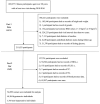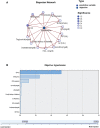Association of Lipid Levels With the Prevalence of Hypertension in Chinese Women: A Cross-Sectional Study Based on 32 Health Check Centers
- PMID: 35873005
- PMCID: PMC9300912
- DOI: 10.3389/fendo.2022.904237
Association of Lipid Levels With the Prevalence of Hypertension in Chinese Women: A Cross-Sectional Study Based on 32 Health Check Centers
Abstract
Background: Dyslipidemia is strongly associated with the development of hypertension. In our previous study, it was shown that elevated TC, LDL-c, and non-HDL-c were associated with the prevalence of hypertension in Chinese men, whereas the relationship between HDL-c and hypertension shifted from no association to a positive association after adjusting for the BMI. To further accumulate epidemiological evidence in Asian women, this study aimed to investigate the relationship between lipid profile and prevalence of hypertension in Chinese adult women.
Methods: This is a cross-sectional study including 54,099 Chinese women aged>20 years at 32 health screening centers in 11 cities from 2010-2016. The original data were obtained from DATADRYAD database (www.datadryad.org). Besides, the overall women were classified into non-hypertensive and hypertensive groups based on baseline blood pressure levels. Differences between the two groups were examined by Man-Whitney test or Chi-square test. Spearman's correlation coefficient was employed to evaluate the correlation between systolic blood pressure (SBP), diastolic blood pressure (DBP) and lipid profiles. Multivariate logistic regression was performed to estimate the relationship between different lipid levels and the prevalence of hypertension. Odds ratios (ORs) and 95% confidence intervals (CIs) indicated the risk of lipid and hypertension. Bayesian model (BN) model was constructed to further assess the relationship between baseline characteristics and the prevalence of hypertension, as well as the importance of each variable for the prevalence of hypertension.
Results: Compared to the non-hypertensive population, the hypertensive population was older, and had the higher body mass index (BMI), total cholesterol (TC), low-density lipoprotein cholesterol (LDL-c), serum creatinine (Scr), fasting blood glucose (FPG), blood urea nitrogen (BUN), alanine aminotransferase (ALT), aspartate aminotransferase (AST), and non-high-density lipoprotein cholesterol (non-HDL-c), but HDL-c and the presence concerning the family history of diabetes were lower. Multivariate logistic regression analysis revealed that TC, LDL-c, and non-HDL-c showed a positive trend with hypertension risk (p for trend < 0.05) whereas TC and HDL-c were not significantly associated with hypertension prevalence. Moreover, each 1 mg/dl increase in TC, LDL, and non-HDL hypertension prevalence increased by 0.2% [1.002 (1.000-1.003)], 0.2% [1.002 (1.000-1.004)], and 0.2% [1.002(1.001-1.004)], respectively. BN suggested that the importance of age, BMI, FPG, non-HDL-c on the prevalence of hypertension was 52.73%, 24.98%, 11.22%, and 2.34%, respectively.
Conclusion: Overall, in Chinese adult women, TC, LDL-c and non-HDL-c levels were higher and HDL-c level was lower in the hypertensive population, whereas TG did not differ significantly from the non-hypertensive population. Meanwhile, TC, LDL-c, and non-HDL-c were positively associated with prevalence of hypertension, and HDL-c was negatively associated with prevalence of hypertension but became nonsignificant after full adjustment for variables. Moreover, BN model suggested that age, BMI, FPG, and non-HDL-c had a greater effect on the development of hypertension.
Keywords: high-density lipoprotein cholesterol; hypertension; lipids; low-density cholesterol; total cholesterol; triglycerides.
Copyright © 2022 Deng, Li and Cheng.
Conflict of interest statement
The authors declare that the research was conducted in the absence of any commercial or financial relationships that could be construed as a potential conflict of interest.
Figures



Similar articles
-
Relationship Between Lipid Profiles and Hypertension: A Cross-Sectional Study of 62,957 Chinese Adult Males.Front Public Health. 2022 May 18;10:895499. doi: 10.3389/fpubh.2022.895499. eCollection 2022. Front Public Health. 2022. PMID: 35664125 Free PMC article.
-
The Association between Serum Lipid Profile Levels and Hypertension Grades: A Cross-Sectional Study at a Health Examination Center.High Blood Press Cardiovasc Prev. 2025 Jan;32(1):87-98. doi: 10.1007/s40292-024-00683-9. Epub 2024 Nov 27. High Blood Press Cardiovasc Prev. 2025. PMID: 39602007
-
Gender impacts on the correlations between nonalcoholic fatty liver disease and hypertension in a Chinese population aged 45-60 y.Clin Exp Hypertens. 2016;38(7):639-643. doi: 10.1080/10641963.2016.1182181. Epub 2016 Sep 28. Clin Exp Hypertens. 2016. PMID: 27680771
-
The differences of serum lipid profiles between primary aldosteronism and essential hypertension: a meta-analysis and systematic review.BMC Endocr Disord. 2022 Aug 31;22(1):217. doi: 10.1186/s12902-022-01135-y. BMC Endocr Disord. 2022. PMID: 36045354 Free PMC article.
-
A systematic review of population-based studies on lipid profiles in Latin America and the Caribbean.Elife. 2020 Aug 18;9:e57980. doi: 10.7554/eLife.57980. Elife. 2020. PMID: 32807300 Free PMC article.
Cited by
-
Pro-Inflammatory Markers in Serum and Saliva in Periodontitis and Hypertension.Medicina (Kaunas). 2025 May 31;61(6):1024. doi: 10.3390/medicina61061024. Medicina (Kaunas). 2025. PMID: 40572711 Free PMC article.
-
Assessment of lipid parameters and its association with risk of stage 1 hypertension: a cohort study in middle-aged and elderly Chinese.Aging (Albany NY). 2025 Jul 14;17(7):1868-1880. doi: 10.18632/aging.206280. Epub 2025 Jul 14. Aging (Albany NY). 2025. PMID: 40664455 Free PMC article.
-
Exploring clinical indicator variations in stroke patients with multiple risk factors: focus on hypertension and inflammatory reactions.Eur J Med Res. 2024 Jan 29;29(1):81. doi: 10.1186/s40001-024-01653-6. Eur J Med Res. 2024. PMID: 38287458 Free PMC article.
-
Impact of fundamental components of the Mediterranean diet on the microbiota composition in blood pressure regulation.J Transl Med. 2024 May 3;22(1):417. doi: 10.1186/s12967-024-05175-x. J Transl Med. 2024. PMID: 38702795 Free PMC article. Review.
-
Increased high-density lipoprotein cholesterol in patients with type 2 diabetes and its correlates: a cross-sectional, matched case-control survey.Eur J Med Res. 2024 Jul 2;29(1):355. doi: 10.1186/s40001-024-01950-0. Eur J Med Res. 2024. PMID: 38956709 Free PMC article.
References
-
- Chruściel P, Stemplewska P, Stemplewski A, Wattad M, Bielecka-Dąbrowa A, Maciejewski M, et al. . Associations Between the Lipid Profile and the Development of Hypertension in Young Individuals - the Preliminary Study. Arch Med Sci AMS (2022) 18:25–35. doi: 10.5114/aoms.2019.86197 - DOI - PMC - PubMed
MeSH terms
Substances
LinkOut - more resources
Full Text Sources
Medical
Miscellaneous

